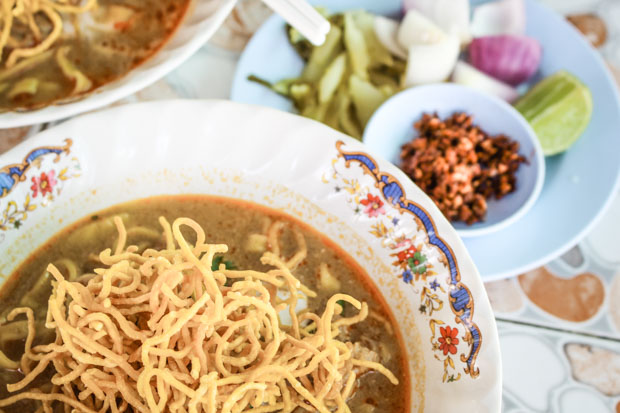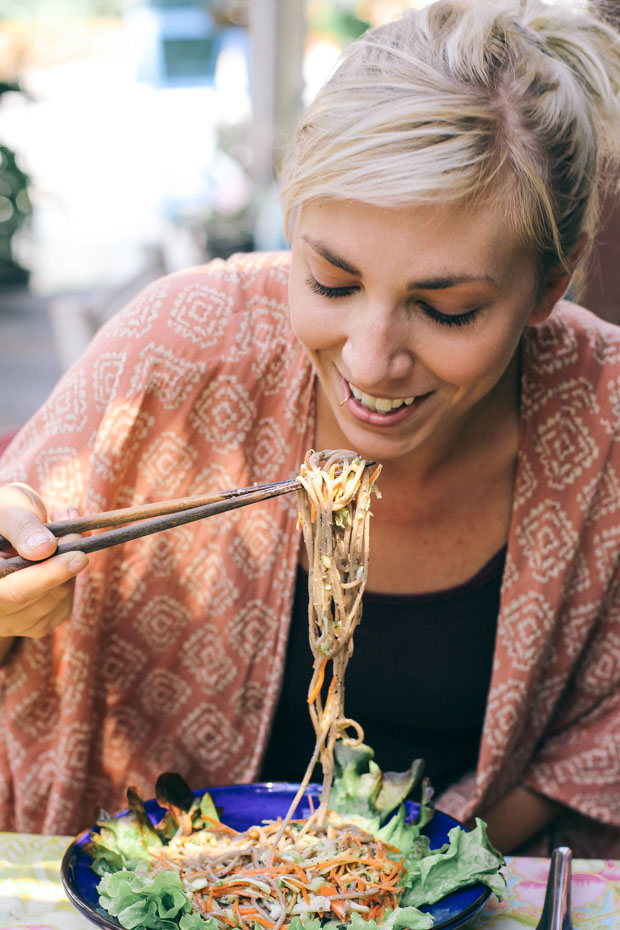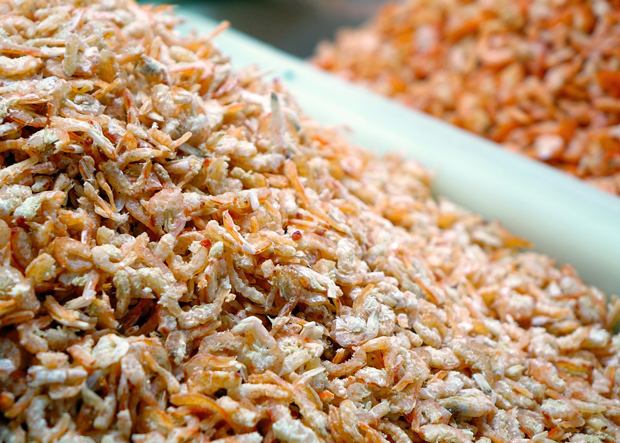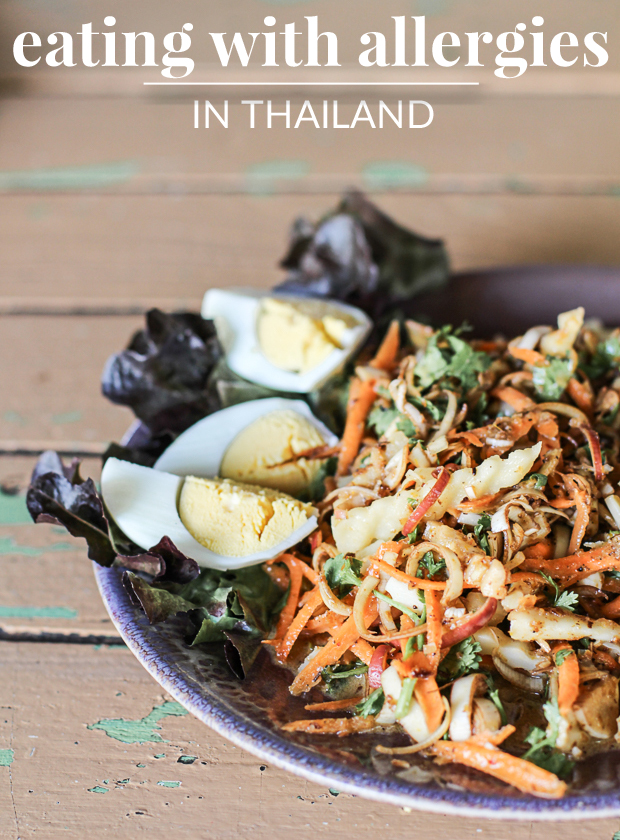
Dealing with Dietary Restrictions in Thailand
When I was writing my ‘how to order in Thailand‘ post, a lot of questions came up about how to order safely for certain dietary restrictions, mainly regarding gluten and peanut sensitivities or allergies.
Personally, I will try anything and everything when I’m traveling and don’t have any food allergies or restrictions. I tend to not eat a lot of meat, but also don’t avoid it and often will opt for local food that maybe isn’t the healthiest, but is the most affordable and accessible. For example, there are a ton of delicious veggie restaurants in Chiang Mai that source organic ingredients, don’t use MSG, etc., however I’ll get veggie and tofu fried rice from a street stall (with sodium-packed fish sauce, sugar and most likely MSG) because it’s cheaper, more convenient and how many people eat here. (You don’t see a lot of typical Thai customers in the higher-priced vegetarian places…)
Because I’m usually not too picky or restricted in what I eat, I certainly couldn’t speak to concerns about ordering or eating in Thailand with allergies all on my own so contacted some smart ladies who know more than me.
Jodi Ettenberg of Legal Nomads has been traveling for the past eight years with celiac disease and knows Thailand well, while Stella from Stella Wellness is a Thai native now based in Bangkok working to encourage and educate others on choosing healthy eating options.
Before we dive into all this, honestly for dietary restrictions, or any other order modification for that matter, my biggest concern is fully trusting that the person taking your order or preparing the food a) understands you and b) actually cares.
People here are quite good at just smiling and nodding and that doesn’t necessarily mean they understand you or will take your concerns seriously. Jodi agrees with me. She tends to stick to made-to-order street food and trusts it more since she can watch the person cooking and stop them if they reach for an ingredient she doesn’t want included.
You’ve been warned.

How to Eat Vegetarian or Vegan in Thailand
You’ll be able to find plenty of vegetarian and vegan options in Bangkok, Chiang Mai, Pai and several of the popular Thai islands such as Phuket, Koh Samui or Koh Phangan. The country has such a wealth of fresh produce all year round and in these tourist hubs eating vegetarian or vegan is a bit of a trend with plenty of restaurants focusing on vegetarian, vegan and raw dishes. The food is often good, but priced closer to Western restaurant prices – no $1.00 plates – and you’ll be eating mainly with other tourists and expats.
There are also local vegan Thai places found throughout the country that can be identified with the red and yellow “เจ” signs. เจ (jay) means vegan in Thai while มังสวิรัติ (mung-sa-wee-rut) means “vegetarian”. At these restaurants, all of the dishes are made without the use of eggs, fish sauce or oyster sauce but often do include substitute meat products made from mushrooms, soy, tempeh or textured vegetable protein.
That said, most Thai dishes come with meat, often not a lot, but it’s there. Usually dishes, such as stir fries, soups or curries, can be easily made without the meat or replaced with tofu, but you have to ask. Also, sometimes if you ask for a certain dish to be made เจ, you’ll be told “not possible”. Sometimes I think this is due to laziness on the part of the person taking your order or cooking, but other times it’s because the dish requires eggs, or they don’t have soy or mushroom sauce to take place of the usual fish or oyster sauce. “Jay” is easier to say, but if you’re mainly just concerned with not having actual meat in the dish try “mung-sa-wee-rut“.
How to Eat Gluten-free in Thailand
At first I assumed eating gluten-free in Thailand would be relatively easy, I’ve now learned it’s not because of soy sauce having wheat in it. Jodi says that meats are often marinated in soy sauce, and it’s also used in a lot of soups, noodle dishes and even some curries. In fact, she has a much harder time eating in Thailand than Vietnam. (Note that for those who are gluten-free, Jodi’s site is a great resource for how to travel in general while eating gluten-free and she has super helpful free gluten-free travel guides and translation cards available for Japan, Greece, Italy and Vietnam with China, Morocco, Spain – and Thailand! – in the pipeline.)
Stella adds that those who are celiac or are gluten sensitive should beware of street fried bananas, (gluay tot) which contain wheat flour in the batter and the famous little Thai coconut pancakes (khan kook). If in doubt, always ask if it contains wheat flour – bang sa-lee. There are plenty of delicious gluten-free dessert options, like mango with sticky rice (khao nieow mamaung), sticky rice with banana in banana leaves (khao tom mat), banana in coconut milk (gluay but she). Stir fries also contain hidden wheat/ gluten for they usually contain oyster (naam mun hoy) or soy sauce (naam see ew) or both, with the oyster sauce being thickened with a modified wheat starch and soy sauce containing wheat in the fermentation. Soy sauce comes in two forms, dark soy and light soy; both can darken the food so if you see a brown discoloration that doesn’t look natural, it likely contains soy.
When ordering street food it can be a little bit of a challenge, practice saying “Mai ow naam see ew” (I don’t want any soy sauce). To ask for gluten-free soy sauce is even more challenging as the street vendor will not have it unless you bring your own.
At restaurants you can opt for salt (bak) or fish sauce (naam bplaa) to replace the soy. Stella sometimes carries with her the Lumlum or Lemon Farm soya sauce which is free from wheat which you can easily purchase at any leading supermarket in Thailand. Another wheat/gluten trap is when ordering noodles, stick with the white color rice noodles and the clear vermicelli noodles made from mung beans while staying away from the yellow egg noodles (ba nee) which has a component of wheat flour. Some noodle stalls also has a soy-based addition into their soup broth, so stick to clear soup or opt for no soup. Again, when in doubt can ask whether the soup (same word in Thai!) contains naam see ew.
Lastly some street vendors do not adequately wash their wok between customers’ meals which can lead to gluten contamination so be cautious. Some gluten-free Thai street food options are green papaya salad (som tam) made with young papaya, shrimp (optional), tomatoes, carrot, chilies, green beans, peanuts (optional), sugar, lime, garlic, fish sauce, grilled chicken with sticky rice, most Thai curries are gluten-free safe or soups like tom cha (galangal) soup, which is a coconut milk-based soup with galangal, lemongrass and kaffir lime, served with mushrooms and often chicken.
How to Eat Safely with a Peanut Allergy in Thailand
Despite what you may think based on the Thai dishes that are popular elsewhere in the world, most Thai dishes do not include peanuts. I have had “Thai peanut sauce” with satay maybe three times in the past 5 years and it’s not used in other dishes except for “Swimming Rama”, a dish with greens, meat or tofu, that I’ve actually never even eaten in Thailand. However, crushed peanuts do pop up from time to time. Bella says to be aware of phad thai, som tam, satay skewers, tapioca dumplings (saku san mu), rice flour crepes (khao kris oak mo), but that most restaurants are flexible and accommodating if you ask them to steer away from the peanuts and not to cross contaminate. If you order a dish like phad thai that may contain peanuts you can:
If you’re a woman say: ฉันแพ้ ถั่วลิสง – chan pair tua lee-song
If you’re a man say: ผมแพ้ ถั่วลิสง – pom pair tua lee-song
ถั่วลิสง, or too lee-song, means “peanut” while แพ้, pair, means “allergic”. Due to the difficulty of some Thai pronunciation – แพ้ is a little difficult with an airy “r” sound instead of a hard “r” like Americans tend to say – write the saying out in English and Thai. Drawings are also good just for extra clarification; a peanut with an X through it is pretty clear. This post has some more helpful tips about how to communicate your allergy to the person you’re speaking to.
How to Eat Safely with a Shellfish Allergy in Thailand
Fresh shrimp is often found in phad thai and tom yum soup while tiny dried shrimps are used in a wide range of dishes, including phad thai and som tam, to add flavor. Shrimp in Thai is กุ้ง, pronounced “goong” with a falling tone. The dried shrimp is called “goong hang”.
If you’re allergic to shrimp and a woman say: ฉันแพ้กุ้ง – chan pair goong
If you’re allergic to shrimp and a man say: ผมแพ้กุ้ง – pom pair goong

How to Eat Dairy-free in Thailand
Thai cuisine is coconut milk-based and not dairy-based so dairy-free options are plentiful. However the cow milk (nom in Thai, pronounced nome) has crept into dishes like creamy tom tom (tom yum khon) which uses canned evaporated milk, Thai-style coffee and tea which has both evaporated milk and condensed milk and sweet coconut bread dip (sangkhaya). Some brands of coconut ice cream mix milk powder into the ice cream, so if in doubt as if it contains milk.
Well, there you have it. If you have any questions or any other tips to share about eating in Thailand please share them in the comments below!
Need to save this info? Pin it for later!

 Stella is a Certified Health Coach, Wellness Consultant and Healthy Chef based in Bangkok. When she is not creatively creating up a wholesome meal or menu, she is with nature moving her body through yoga, trekking out to the rural farms around Thailand and teaching others to do the same. She is constantly fuelled by her love and passion for nutrition, organic farming and creating new healthy menus. She is also a believer in the healing power of living harmoniously with nature. You can find her at www.stellawellness.com, on Facebook or Instagram.
Stella is a Certified Health Coach, Wellness Consultant and Healthy Chef based in Bangkok. When she is not creatively creating up a wholesome meal or menu, she is with nature moving her body through yoga, trekking out to the rural farms around Thailand and teaching others to do the same. She is constantly fuelled by her love and passion for nutrition, organic farming and creating new healthy menus. She is also a believer in the healing power of living harmoniously with nature. You can find her at www.stellawellness.com, on Facebook or Instagram.
 Jodi Ettenberg is a writer, photographer, and public speaker exploring the world full-time since April 2008. Her website, Legal Nomads, tells the stories of places she visits, often through food. She is also the author of The Food Traveler’s Handbook and recently won a Lowell Thomas Award and three North American Travel Journalist awards for her writing and photography. She has been featured in the New York Times, National Geographic, BBC Travel, and more. Prior to founding Legal Nomads, Jodi worked as a lawyer in New York for 5 years. You can find her at www.legalnomads.com, on Facebook or Instagram.
Jodi Ettenberg is a writer, photographer, and public speaker exploring the world full-time since April 2008. Her website, Legal Nomads, tells the stories of places she visits, often through food. She is also the author of The Food Traveler’s Handbook and recently won a Lowell Thomas Award and three North American Travel Journalist awards for her writing and photography. She has been featured in the New York Times, National Geographic, BBC Travel, and more. Prior to founding Legal Nomads, Jodi worked as a lawyer in New York for 5 years. You can find her at www.legalnomads.com, on Facebook or Instagram.
Hey! I'm Alana and I've spent nearly the past decade living in Chiang Mai, Thailand, working as a writer and photographer. I started Paper Planes as a place to share local insight, special places, and how to travel well through a range of experiences — from hostels to high-end hotels, street meat to multi-course meals.
New places are always calling my name...
1/11/17
Leave a Reply
let me join you in your inbox
Enter your email for a taste of different worlds, must-read posts, and special offers.
(Don't worry, I'll never spam you — just send the good stuff.)
Definitely saving this for later (assuming I get the opportunity to go to Thailand later haha) – super helpful! I’m celiac and I’ve never been to Asia – but one of the things holding me back is how much soy sauce they use! So this is a great resource 🙂
I can’t imagine what it must be like constantly needing to be aware of all the ingredients in your food… It takes some caution, but it is possible to eat – and eat well – here! If you haven’t before, definitely check out Jodi’s site for more information about traveling in Asia and elsewhere.
I think if you’re doing Airbnb (or couchsurfing), self-catering is also a realistic and convenient option nowadays to deal with dietary restriction. You can pretty much order food online from most supermarkets in the biggest cities (using anything from LINE man to Happy Fresh or the individual supermarket websites and apps). Most of them are dual-language interfaces (no need to speak or write Thai). Plus places like HappyFresh even have nutrition labels online, so you see right away the exact ingredients.
After living in Thailand for more than 10 years I found the food to still be really delicious, but it’s often not the healthiest choice due to a lot of sugar and oil being used in cooking. Nowadays I self-cater a lot – which also resulted in a lower rate of stomach issues.
Thanks, vey useful guide. We will pin it for our guests.
Important info for those affected by food allergies and those who make conscientious meal choices … great post!
Do you have any suggestions for a coconut allergy? Obviously I can adapt the peanut information to coconut, but it’ll be harder to figure out if I can eat curries and other things.
Wow – I’ve never even thought of that! Some of the popular dishes that come to mind with coconut milk are most curries (green, penang, etc.), khao soi, tom kha soup, and many Thai-style desserts (including mango with sticky rice). Here are some translations:
— “Coconut” is “maprao” (มะพร้าว)
— “Coconut milk” is “ga-teet” (กะทิ)
— “Coconut water” is “naam maprao” (น้ำมะพร้าว)
— “Coconut oil” is “naam-mun maprao” (น้ำมันมะพร้าว)
Hope that helps a little!
I have a stomach ulcer and should not eat any spicy food. I know that foreigners can say “not spicy” but often I have found that it is still way too spicy for me. What else could I say that would convey my problem
There are plenty of dishes that don’t come with chilies, like fried noodle dishes, noodles soups, stirred vegetables in oyster sauces, etc. If you eat at places more geared toward foreigners, dishes with chilies will automatically be less spicy than usual. Instead of just saying ‘mai pet’ or not spicy, you can also say ‘mai pet leuhy’ (meaning not spicy at all) or ‘gin pet mai dai’ (meaning I can’t eat spicy).
ไม่เผ็ด = not spicy
ไม่เผ็ดเลย = not spicy at all
กินเผ็ดไม่ได้ / กินเผ็ดไม่ได้เลย = can’t eat spicy / can’t eat spicy at all (for more emphasis)
Thanks so much for the info on vegan and vegetarian cautions. It’s really helpful to know the terms for vegan and vegetarian, especially. Another great post!
How widely known is the word “Jay” for vegan in Thailand, does everyone understand what it means, I sometimes still have to explain the word vegan in the UK